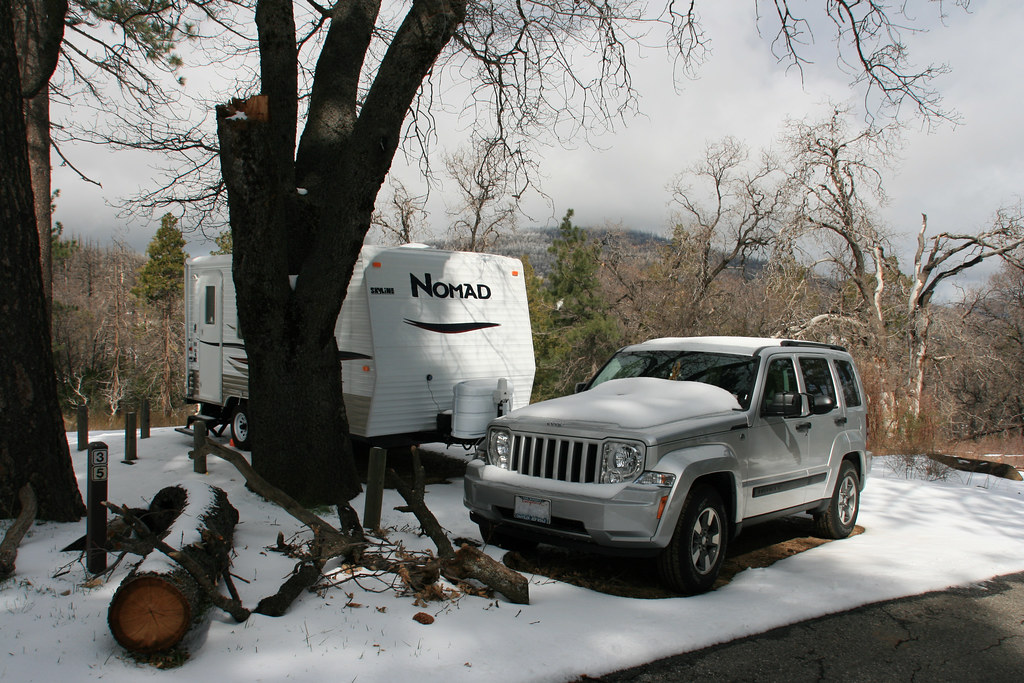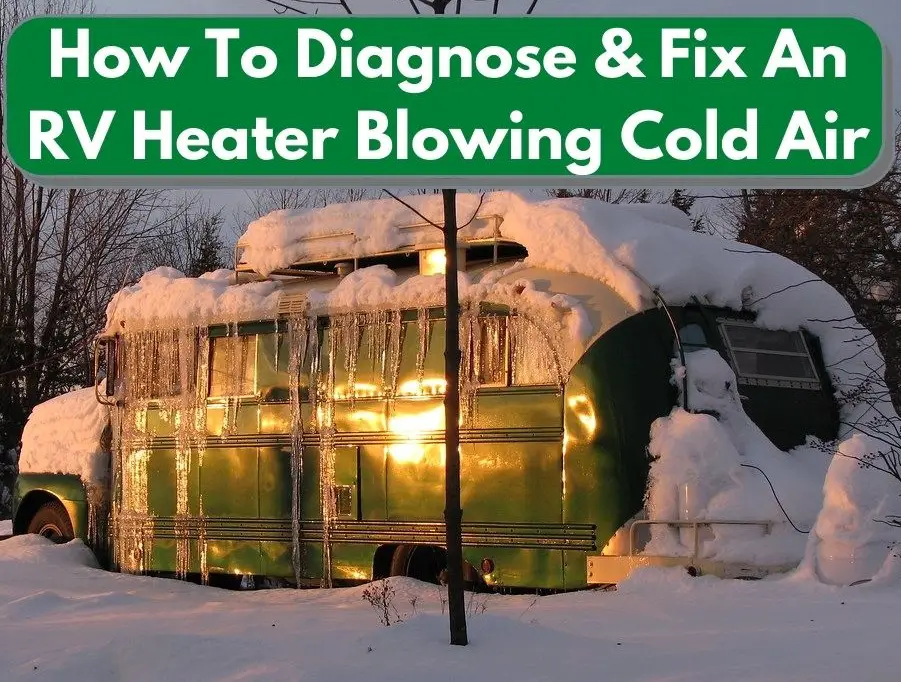Having an RV heater blowing cold air never happens at a convenient time – chances are you’re camping in chilly weather and trying to stay warm, so your RV heater not working is something that needs to be fixed quickly.
Let’s go through the most common reasons your RV heater is blowing cold air along with ways to fix them so you can stay warm.
Reasons Why An RV Heat Pump Is Blowing Cold Air
Before we can fix the RV furnace issue, we first need to diagnose the problem.
Your RV heater has a series of electronics, sensors, relays, and a fuel system to both start up and make heat, each of which can break down or fail and cause a heater in RV blowing cold air.
Here are the most common problems and solutions for a propane RV furnace blowing cold air.
Tripped Circuit Breaker
You might get lucky and the RV furnace isn’t turning on due to a lack of power.
Check the circuit breaker and make sure it’s in the ‘on’ position.
Low Battery Voltage
Unlike the furnace in your home which only blows once the air is fully warmed, the RV furnace starts blowing right away.
If the batteries are too low to power the fan motor or blower motor, your heater in your RV will blow cold air instead.
Try connecting to shore power to recharge your batteries and see if this helps solve the issue.
Dirty Air Filters
Dirty air filters restrict air flow, causing your RV heater to overheat and shut off quickly.
If you’re noticing an initial burst of warm air followed by cold air, this could be the cause of your problem.
Go ahead and clean your air filters at this step in the process, as you’ll want to rule that out (and you should do it as routine maintenance anyway).
Failed Or Dirty Thermostat
Although this is unlikely, you could just have some buildup in your thermostat or something else could be failing.
Take the RV thermostat cover off and blow on it with your mouth or compressed air to loosen any dirt or debris on the circuit board or controllers.
You could get lucky with a really easy fix!
Sail Switch
A bad sail switch is an extremely common issue with RV heaters blowing cold air.
The sail switch is a small switch that opens once your heater fan gets up to full speed which then allows the heat to come out.
If the switch is blocked by dust, hair, debris, rust, insects, or anything else, it will not open and your RV heater will blow cold air.
Fortunately, this is an inexpensive part that can be easily replaced. Take a look at this video for how to repair an RV sail switch:
Fan Motor Not Functioning At Full Speed
Sometimes your RV furnace’s fan motor will be obstructed or otherwise not fully functioning – if it can’t get up to full speed, the sail switch won’t open, and then your camper heater will blow cold air.
If you’ve ruled out the sail switch as the problem, check and clean the fan motor as well to see if this is where your issue is coming from.
Propane Vs Electric Vs Diesel RV Furnaces
Some RV heaters are powered by electric while others are powered commonly by propane.
Here are the most common problems and solutions for a propane RV furnace blowing cold air.
This is an important distinction because it will help you narrow down the cause and fix to your problem, so first find out which fuel source your RV furnace uses.
RV Propane Heater Blowing Cold Air – Causes & Fixes
Fuel Source
This may seem obvious, but if your propane tanks are low or empty then your RV furnace has no fuel to burn and will blow cold air.
Gas Valve
Assuming you have fuel, when the fuel is sent to your heater the gas valve will open which allows the fuel to be ignited and burned to produce hot air.
If your gas valve is faulty and won’t open, there’s no fuel to be burned, so your RV heater will produce cold air instead.
Listen when your furnace is starting and you can hear a clicking noise which means your gas valve is opening.
In some cases you could hear a click but the gas valve still may not be opening, and in this case you’ll need to test the valve with a separate 12V power source to make sure what the problem is.
Additionally, there is a small orifice on your gas valve which can become blocked by dirt or debris – check this and remove any blockages to be sure that’s not the case.
Propane Tank Emergency Shutoff Valve Triggered
Occasionally you can open your propane valve too quickly, which can cause an emergency shutoff (aka a flow limiter valve) to be activated.
To check if this is the problem, shut everything off and close the propane valve.
Wait a few moments, then open the propane valve very slowly until you hear a hissing sound, then open the rest of the way slowly.
Turning your propane on this way will prevent the emergency shutoff from being activated unnecessarily.
Dirty Flame Sensor Or Thermocouple
The flame sensor (also called a thermocouple) is an important safety element on your RV furnace which prevents explosions.
If you notice that the air feels warm for a moment but then switches to cold air, you may have a dirty flame sensor.
You can try cleaning the flame sensor with steel wool to see if this resolves the issue, otherwise you may need to replace it.
Too Much Butane In Your Propane
Propane is usually sold mixed with butane, and this is no issue in warmer weather.
However, butane turns from a gas to a liquid at any temperature below freezing.
Most propane dealers have different seasonal mixes to account for this, but if you’re still running a propane tank that you were using during the summer, this could be the cause and you’ll need to get a different mix of propane with a lower butane content.
Ignitor
Your RV heater will make a fast ticking sound when starting up, which is the ignitor making a spark inside the combustion chamber.
The gas is sent to the chamber and ignited by the spark, which then lights the fuel to produce hot air from your RV furnace.
If the ignitor is failing, there’s no spark and you’ll have a camper furnace blowing cold air.
To check this, disconnect the gas and remove the ignitor from the combustion chamber.
You should visually be able to see a spark jumping between the ignitor tips if it’s working properly.
If there’s a weak spark or no spark at all, you likely need to replace the ignition module.
Take a look at the ceramic insulation and try to find any cracks, also checking the gap between the ignitor tips and making sure there are no holes in the combustion chamber.
RV Electric Heater Blowing Cold Air – Causes & Fixes
Ambient Temperature Too Low
Electric RV heaters are only designed to work down to about 40F.
If you have an electric-only or electric-propane hybrid system and the propane is shut off, your RV electric heater will blow cold air if the outside operating temperature drops too low.
RV Diesel Heater Blowing Cold Air – Causes & Fixes
Although RV diesel furnaces are rare, some RVers have upgraded their system or bought a high-end RV that came with one preinstalled.
Carbon Buildup
Sometimes carbon can build up in your RV’s diesel furnace and cause air to blow cold.
This can usually be resolved by realigning your outlets so that your furnace’s output is not blowing so close to your furnace’s input.
How Does An RV Heater Work?

Understanding how your RV heater works goes a long way in helping you to diagnose and fix problems.
Although there are small differences by fuel source and model, all RV furnaces use this general process:
- The RV thermostat sends a request for heat, sending a current to the RV heater.
- The electricity powers a time delay relay which passes power to the RV heater blower.
- The blower begins to spin, bringing in air from the air return.
- Another fan pulls air into the combustion chamber.
- The blower speed increases which triggers the sail switch.
- Power flows through the high limit switch and then to the control circuit board.
- The power at the control circuit board opens the gas supply and tells the ignitor to spark.
- The spark ignites the gas in the combustion chamber, creating hot air.
- Heat passes into the heat exchanger which heats the air passing through the ducts.
- Once the temperature reaches the setting of the thermostat in the RV, the furnace will shut down.
- The furnace fan continues to run to cool the RV furnace for a little while after this process takes place.
How To Reset An RV Heater
Sometimes a simple reset may get things working again, so this is always worth a try.
The RV heater’s reset button is located inside the blower compartment on the side of the furnace motor and is usually a red button which is labeled ‘reset’.
Turn off the power supply and shut off the gas to your camper furnace, press the button, and turn everything back on and see if your RV heater is still blowing cold air or if everything is working fine.
Additionally you can pull the RV heater fuse, wait a few minutes, then replace the fuse as well (also make sure power and fuel are turned off if doing this process).
Wrapping Up How To Fix An RV Heater Blowing Cold Air
We hope this guide helped you to diagnose and correct your issue and get your RV warmed back up!
What was the cause and solution to your problem, and how did you diagnose it? Let us and your fellow RV’ers know in the comments below.
If you’re the DIY-ing type, check out our other guides to the best RV outdoor kitchen mods, how to prepare for an RV one night freeze, how to fix a sagging RV slide out, fixing an RV air conditioner freeze up, and what to do if your RV microwave isn’t working.


Is there a reason the furnace starts blowing cold air when there is still half a tank of propane? Why can’t it run until the propane tank is actually empty?